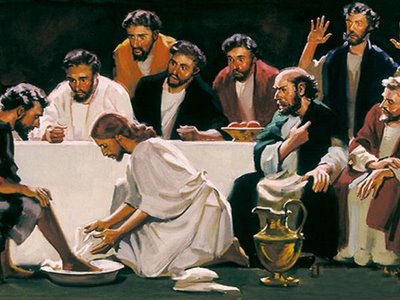THE SEED
After that he poureth water into a bason, and began to wash the disciples’ feet.John 13:5
Jesus started washing people’s feet after taking off His outer clothes. Despite who He was, He provided the greatest example of service imaginable. To prove that there is monarchy in service and ministry, he took the most extreme conduct possible. The lowest of jobs for the lowest of slaves was washing people’s feet. We can see the need for royal service here. Jesus washed the disciples’ feet in order to show them the importance of service and ministry, motivated by three factors. He first understood that the time had arrived for His death and that He had little time left. Second, He had to start teaching His disciples whatever it was that He wanted to teach them. He loved all of His disciples, both in heaven and on earth, and He also loved His disciples. They were all beloved to him. No of the cost, he felt driven to aid them in any way he could. The enemy was going to attack and betray Him, and He knew who they were. Before the enemy struck, he had to take action. It was necessary to fortify and bolster the disciples. It would be too late once the enemy hit. In order to help other Christians walk in open confession and to be washed and cleaned from the dirt of the world, we Christians are called to serve them royally and selflessly. Jesus calls us to serve others by humbly attending to their basic human needs. He wants us to introduce people to Christ so that He might wash them clean from the impurities of the world and minister to their spiritual needs.
PRAYER
May I be humble and meek in my relationship with others.
BIBLE READINGS: John 13: 1-7
IṢẸ ÌSÌN JÉSÙ TÓ NI ỌLÁ
IRUGBIN NAA
Lẹhin náà o bu omi sinú awokoto kán, o si bẹrẹ sí máa wẹ ẹsẹ àwọn ọmọ ẹhìn rẹ. Johannu 13:5
Jésù bẹrẹ sí fọ ẹsẹ àwọn ènìyàn nigbati o bọ aṣọ ileke Rẹ sílẹ. Pẹlú iru ipo ti o ni. O fún wá ni apẹrẹ iṣẹ ìsìn ti o tóbi kọjá òye. Iṣẹ tí o kere ju fún ẹrú ní iṣẹ ẹsẹ fifọ fún àwọn ènìyàn. A o wà rí bí iṣẹ ìsìn tó ní ọ́la ṣe jẹ́yọ ninu ọrọ yí. Jesu fọ ẹsẹ àwọn ọmọ lẹhin rẹ lati fí pataki iṣẹ ìsìn hàn nínú iṣẹ iranṣẹ fún ìdí mẹta yi. Akọkọ, Jésù mọ pé àsìkò ti to fún ikú ati pe asiko diẹ ló kù fún òun. Ìkejì, O bẹrẹ sí kọ àwọn ọmọ ẹhìn Rẹ ni ohunkohun ti o ba fẹ kọ wọn. O fẹran gbogbo àwọn ọmọ ẹhìn Rẹ, l’ọ̀run àti ní ayé, wọn jẹ àyànfẹ fún ùn. Iketa O nfẹ lati máà ran wọn lọwọ pẹlú gbogbo ipá Rẹ. Ọtá nlọ lati dojukọọ ati lati fii hàn, O sì mọ awọn ti o jẹ. Kí ọta to gbé ọwọ́ o ti gbé ìgbésẹ, o jẹ ohun ti o yẹ lati gbara di lati da ọtá lẹkun kí o tó ṣe ibí.Yio ti bọ sórí tí ọta bá kọkọ gb’ọwọ. Láti lè ràn awọn kristeni lọwọ nípa ijẹri wọn àti láti wẹ wọn kúrò nínú èérí to wà nínú ayé. Jesu pé wá sí iṣẹ ìsìn fún àwọn ẹlòmíràn pẹlú ìrẹlẹ lati bojuto àìní wọn gbogbo. Jesu fẹ kí afi Oun hàn awọn eniyan ki o bá wẹ wọn mọ kuro ninu èérí inu ayé àti láti ṣe iṣẹ ìríjú fún ìgbàlà ọkàn wọn.
ADURA
Ki èmi kì o Ie ní ìrẹlẹ àti sùúrù lati le ni ajọṣepọ pẹlu awọn ẹlomiran.
BIBELI KIKA: Johannu 13:1-7
